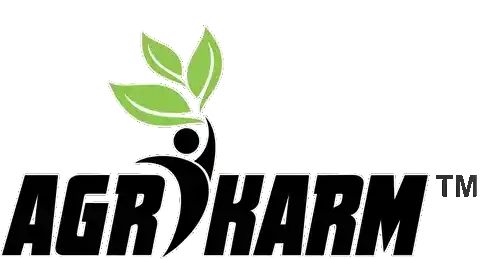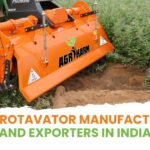
A rotary tiller is a motorized farming tool designed to break up, churn, and aerate the soil. This rotary tiller machine is the most suitable tool for planting crops with ease.
Let’s explore what a rotary tiller is and how a rotary tiller machine can be used on a farm.
Rotary Tiller
A rotary tiller, also known as a rototiller, rotary hoe, or rotavator, is a mechanized agricultural tool used to prepare soil for planting. It consists of a series of blades (tines) that rotate, breaking up and turning over the soil.
This rotary tiller machine is often attached to a tractor for larger farming operations, though smaller, standalone models are available for smaller plots or gardens.
Rotary Tiller Uses
Some of the common rotary tiller uses are:
- Soil Preparation: Rotary tiller for tractor loosens and aerates the soil, making it suitable for planting crops. This is essential for creating a fine seedbed, which promotes better seed germination and root growth.
- Weed Control: By cutting and burying weeds, rotary tillers help to manage and reduce weed growth in agricultural fields.
- Incorporating Soil Amendments: Rotary tillers can mix fertilizers, compost and other soil amendments evenly into the soil, improving soil fertility and structure.
- Landscaping: Rotary tiller machines are used in landscaping to prepare lawns and gardens by breaking up hard ground and incorporating organic matter.
- Residue Management: After harvest, rotary tillers can be used to chop and incorporate crop residues back into the soil, which helps in maintaining soil organic matter and fertility.
- Levelling Ground: They can also help level uneven ground, making it more suitable for planting and irrigation.
Get Agrikarm’s Standard Rotary Tiller for superior soil preparation!
Tips for Using a Rotary Tiller Perfectly on a Farm
While adapting rotary tiller use on your farm you must take into consideration the below mentioned tips.
Prepare the Area: Clear the field of large rocks, branches and other debris that might damage the rotary tiller or interfere with its operation. Confirm that your soil is not too wet or too dry. The soil should be slightly moist for optimal tilling.
Adjust the Tiller: Set the tilling depth according to your crop requirements. Most tillers allow you to adjust the depth of the tines. Check and tighten all bolts and connections before starting.
Proper Tractor Speed: For tractor-mounted tillers, maintain an appropriate speed. Too fast, and you may not till thoroughly; too slow and you may overwork the soil.
Overlap Passes: Overlap each pass slightly to ensure no strips of unturned soil remain between passes.
Avoid Compaction: Avoid making multiple passes over the same area to prevent soil compaction. Ensure the soil is not overly compacted before starting, as this can make tilling difficult and reduce effectiveness.
Consistent Speed and Depth: Maintain a consistent tilling speed and depth throughout the entire field for even soil preparation. Avoid sudden changes in direction or speed to prevent uneven tiling.
Watch for Obstacles: Be vigilant for any hidden rocks, roots or debris that could damage the tines or hinder progress. Stop and remove any obstacles immediately to prevent damage.
Maintenance: Regularly check and clean the tines to ensure they remain sharp and free of soil build-up. Lubricate moving parts as per the manufacturer’s guidelines to keep the tiller in good working condition.
Safety Precautions: Always wear appropriate safety gear, such as gloves, eye protection, and sturdy footwear. Keep bystanders, largely children and pets, away from the operating area.
Post-Tilling: Inspect the tilled soil for consistency and make any necessary adjustments if certain areas are not tilled properly. Clean the tiller thoroughly after use to prevent rust and prolong its lifespan.
FAQs About Rotary Tiller
What are the different types of Rotary Tillers?
- Mini rotary tillers: Suitable for small gardens and plots.
- Medium-duty rotary tillers: Ideal for medium-sized farms and gardens.
- Heavy-duty rotary tillers: Designed for large farms and tougher soil conditions.
How do I maintain a rotary tiller?
- Regular cleaning: Remove soil and debris after each use.
- Check and replace blades: Inspect blades for wear and damage, replacing them as necessary.
- Lubrication: Frequently grease the moving parts to ensure smooth operation.
- Tighten bolts and nuts: Ensure all fasteners are secure to prevent mechanical issues.
- Storage: Store in a dry place to prevent rust and corrosion.
What safety precautions should I take when using a rotary tiller?
- Read the manual: Familiarize yourself with the equipment before use.
- Wear protective gear: Gloves, eye protection, and sturdy footwear are essential.
- Check the area: Remove any large stones, debris or obstacles from the soil.
- Use caution: Avoid loose clothing and be aware of your surroundings to prevent accidents.
- Follow tractor guidelines: Ensure the PTO is properly engaged and operate the tiller at recommended speeds.
FINAL VERDICT
Rotary tillers are a requisite for gardening, farming and landscaping to prepare seedbeds, manage soil and incorporate organic matter. By grabbing those tips, you can ensure efficient and effective use of your rotary tiller, leading to well prepared soil that promotes healthy crop growth.


 Admin
Admin 

